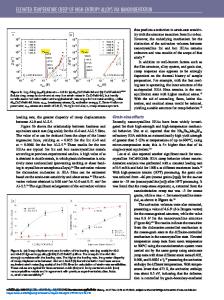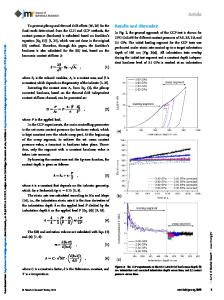Size effects of nanoindentation creep
- PDF / 5,936,291 Bytes
- 10 Pages / 612 x 792 pts (letter) Page_size
- 44 Downloads / 402 Views
The size effects on indentation creep were studied on single-crystal Ni3Al, polycrystalline pure Al, and fused quartz samples at room temperature. The stress exponents were measured by monitoring the displacement during constant indentation loads after correction for thermal drift effects. The stress exponents were found to exhibit a very strong size effect. In the two metals Al and Ni3Al, the stress exponent for very small indents is very small, and for Al, this even approaches unity, suggesting that linear diffusional flow may be the controlling mechanism. The stress exponents in these two metals rise rapidly to over 100 as the indent size gets larger, indicating a rapid change of the dominating mechanism to climb-controlled to eventually glide-controlled events. In fused quartz, the stress exponent also exhibits a sharply rising trend as the indent size increases. The stress exponent is also close to unity at the smallest indents studied, and it rises rapidly to a few tens as the indent size gets larger.
I. INTRODUCTION
A material surface making a submicrometer-scale plastic contact with a rigid indenter represents an interesting system to investigate. The nominal pressure in this situation is often very high and can easily reach a few percent of the Young’s modulus of the material, so that the ideal strength situation is approached. In crystalline metals, the dislocation density in the contact region is also very high, and independent studies1,2 have indicated that the dislocation density can exceed 1016 m−2. Such contacts are known to creep at an enormous speed at low homologous temperatures at which the same material in the bulk condition would normally not exhibit any creep.3–13 As an example, the nanoindentation results by Feng and Ngan11 indicate that in Ni3Al, an intermetallic compound for high-temperature structural use, the indenter displacement rate h˙ after 10 min of load hold at room temperature becomes steady at approximately 0.01 nm/s when the indenter displacement (h) is about 200 nm. The indentation creep rate h˙/h is therefore of the order 5 × 10−5s−1, which is an enormous creep rate for a high-melting-point material at room temperature. For high-melting materials for which room temperature is normally too low for bulk creep to happen, the occurrence of plasticity is found to be a prerequisite condition for room-temperature indentation creep.10,14 For lowmelting metals like indium, which will creep at room temperature anyway even in the bulk condition, the stress exponent is nevertheless found to be different before and after the strain burst,10 indicating crystal plasticity J. Mater. Res., Vol. 19, No. 2, Feb 2004
will alter the mechanism of indentation creep in these materials. The mechanism leading to such high values of creep rate in submicrometer indents is so far unknown. Li et al.15 have proposed a number of models for indentation creep in the macroscopic situation, but understanding of the nanoindentation creep is very limited. In particular, it is not known how the behavior and mechani
Data Loading...










